EDDY FAMILY TIMELINE
1842: Horatio Eddy was born.
1841 (or 1842): William Eddy was born.
1844: Mary Eddy was born.
1848: Two young teenage sisters, Kate and Maggie Fox of Hydesville, New York, claimed to be in communication with a spirit through “rappings.”
1849 (November 14): Kate and Maggie Fox, along with sister Leah, billed as “The Fox Sisters;” demonstrated their spirit communications at Rochester, New York’s Corinthian Hall.
1862 (July 13): Zephania Eddy died.
1864: William, Horatio, and Mary Eddy began their career performing public séances, staged and managed by the “magnetic practitioner” William Fitzgibbons.
1865: After a time staging public séances in Chittenden, Vermont, the three siblings become a traveling act managed by J.H. Randall.
1866 (December): William and Mary toured with Ira Davenport, founder of the Davenport Brothers.
1872 (December 29): Julia Eddy died.
1873 (September): Increasingly elaborate séances staged both indoors and outdoors drew increasingly large audiences to the Eddy farm in Chittenden.
1874 (August): Journalist Henry Steel Olcott visited the Spirit Vale for five days, on assignment from the New York Sun. He published a letter in the Sun the following week, describing his experience. He returned shortly afterward as an investigator for the Daily Graphic, stayed for twelve weeks, and reported his experiences in a series of articles.
1874 (November): Shaker Elder Frederick Evans witnessed a series of séances at the Eddy farm, reporting that over thirty spirits materialized in one session.
1875 (March): An Eddy-trained assistant confessed to fraud after a highly public exposure, claiming that he was performing as the Eddys taught him.
1875 (April): Olcott published People from the Other World.
1875 (July): Mary Eddy no longer was involved in family performances, instead giving séances solo, in Chittenden.
1875 (November 26): The New York Sun published a detailed expose of fraudulent practices at the Eddy Homestead. Operations in the house ceased, and the family scattered, taking up separate careers.
1910 (December 31): Mary Eddy died.
1922 (September 8): Horatio Eddy died.
1932 (October 25): William Eddy died.
FOUNDER/GROUP HISTORY
Simultaneously a religion, a focus of scientific study, and a highly popular form of public entertainment, Spiritualism, and the practice of public mediumship that purportedly validated it, perfectly exemplified the confluence of religious enthusiasm, empirical inquiry, and p opular entertainment that characterized American culture in the mid-nineteenth century. When the teenage sisters, Kate, Maggie, and Leah Fox of Hydesville, New York launched the Spiritualist movement in 1949 by performances in front of fascinated Rochester audiences in which they claimed to be communicating with spirits, their resultant fame inspired any number of similar performances. The Eddy Family were among the most famous, and most notorious, of the many public medium entertainment acts that rose up in the wake of the Fox Sisters’ celebrity.
opular entertainment that characterized American culture in the mid-nineteenth century. When the teenage sisters, Kate, Maggie, and Leah Fox of Hydesville, New York launched the Spiritualist movement in 1949 by performances in front of fascinated Rochester audiences in which they claimed to be communicating with spirits, their resultant fame inspired any number of similar performances. The Eddy Family were among the most famous, and most notorious, of the many public medium entertainment acts that rose up in the wake of the Fox Sisters’ celebrity.
In their 1870s heyday, the spectacular séances the Eddy Family conducted on their family farm in Chittenden, Vermont [Image at right] brought them international attention in the form of newspaper coverage and thousands of visitors who believed they were truly witnessing spirit materializations. Factual information concerning the history or background of the Eddys, however, is scarce. The parents Zephaniah (1804-1862) and his wife Julia (1813-1872), made a living as farmers, supplemented their income by taking boarders and travelers into their home, and together had eleven children. Of the siblings, Horatio, William, and Mary were the most active, first performing public séances as spiritual and physical mediums on a traveling circuit, and eventually in their own home and on the family land.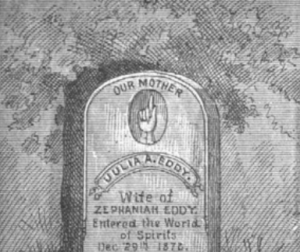
The most extensive account of the Eddys, Henry Steel Olcott’s People From the Other World, contains enough unverifiable information as to not be fully credible, despite the author’s solid journalistic credentials. According to him, the children inherited from their Scottish mother Julia the power of “foreseeing,” which was passed down the female line of her family, and Julia identified as a Spiritualist, over her husband’s objections. The epitaph on Julia’s tomb, “Entered the World of Spirits Dec 29, 1972” does suggest genuine Spiritualist inclinations [Image at right]. No historical record exists, however, to support Olcott’s additional assertion that Julia’s great-great-great grandmother was tried and sentenced to death at Salem for witchcraft in 1692, and neighbors cited in newspaper accounts dispute it. Olcott’s claim that Zephaniah hired out several of the children as a traveling act, during which time they suffered various forms of physical and emotional abuse, is often repeated in stories about the family circulated in popular media. No record of any public performance by any member of the family is available before William, Mary, and Horatio’s debut in 1864, however, which was two years after Zephaniah’s death, when the siblings were all well into their early twenties. Such elements of the family’s backstory, their mother’s hereditary gifts, the early childhood communication with spirits, and ill-treatment and physical abuse in the hands of cruel family members or over-enthusiastic skeptics, are in fact typical of the genre of Spiritualist origin narratives.
For many believers, their apparently spectacular performances summoning and interacting with spirits justified the validity of Spiritualism. Perhaps in order to lend credence to the veracity of spirit encounters, the earliest public séances that William, Horatio, and Mary endeavored were billed as scientific exhibitions rather than religious experiences. William Fitzgibbons, who managed their first traveling exhibition, had previously advertised himself as a magnetic practitioner. For whatever reason, this framing failed to attract audiences. An early performance, staged in Fitzgibbons’ home as a scientific exhibition of “Human Magnetism and Human Electricity,” was pronounced “tedious” by a visiting reporter, and the Eddys “homely and awkward and badly dressed.” Appearing with the Eddys at this same exhibition was professional medium Jennie Ferris, described by the same reporter as “more intelligent and attractive.” Shortly thereafter, the three Eddys and Mrs. Ferris toured as a troupe under Fitzgibbons, very likely learning more professional staging methods and manners during that time. The troupe apparently disbanded in January 1865.
After a few months during which the family conducted public séances in Chittenden, Mary, William, and Horatio resumed traveling performances under the management of J.H. Randall for the remainder of 1865. Probably in response to an exposure scandal as well as an apparent falling-out among the siblings (both notably frequent occurrences in their career), the Eddys retreated from public performances until about December 1866. At that time, William and Mary began traveling (without Horatio) with Ira Davenport on a well-established Spiritualist circuit.
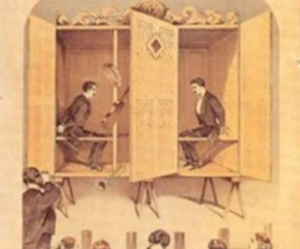
Ira Davenport was father and manager of the Davenport Brothers. Ira and William, the eponymous brothers, were among the first and most famous of the big-name traveling medium acts. Stage magicians by training, their séances featured a piece of stage furniture called a spirit cabinet, a long, narrow box just large enough for two mediums to sit opposite each other within, with holes in various locations that allowed assistants to tie their hands with ropes to prevent trickery, and through which the spirits could emerge to interact with the audience. [Image at right] Another feature of their act was a variety of musical instruments arranged on the cabinet floor that spirits supposedly picked up and played (badly, according to some reports). When some years later the Eddys began conducting séances on their family farm, they notably adapted both of these staging elements.
William and Mary Eddy continued touring with Davenport until January 1867, when they were arrested in Syracuse for performing without a license. After several more exposure scandals, including quarreling siblings exposing each other mid-séance, William, Mary, and Horatio toured separately until approximately 1869.
After a three-year hiatus, during which their mother and an older sister died, the Eddys began to hold daily séances, with increasingly spectacular manifestations. The séances were held on their family farm, which came to be known as The Spirit Vale. Thousands of visitors came to witness these performances, often staying for days or even weeks at a time in the family home, run as a separate business called The Green Tavern. Visitors paid only a modest fee for room and board; the daily séances were conducted free of charge.
The spectacular, seemingly authentic, and apparently convincing Spirit Vale performances soon attracted high-profile attention. On August 28, 1874, the highly respected lawyer, journalist, and military officer Col. Henry Steel Olcott, visited the Spirit Vale, on assignment from the New York Sun. After publishing a letter in the Sun on September 5 describing his experience, Olcott returned as an investigative correspondent for the Daily Graphic. During his stay, he published a lengthy series of letters, detailing the various phenomena he witnessed and relating the history of the Eddy family. He provided detailed drawings of the house and its architecture, the indoor séance room, and the outdoor site, along with his own eyewitness account, as evidence of the authenticity of the manifestations.
During Olcott’s stay, two other important figures also visited the Spirit Vale. One was Helena Blavatsky, who became Olcott’s life partner and co-founder of the Theosophical Society. The other was Elder Frederick Evans, one of the pre-eminent public figures of the Shaker movement. For Evans and other like-minded Shakers, the Eddy séances justified and reinforced the role of Spiritualism in Shaker belief, a position by no means universally held within the movement itself.
Although Olcott’s publication in 1875 of People from the Other World, his book-length account of his experience with the Eddys, brought them greater fame, their reputation precipitously declined near the end of that year. The Eddys, famously intolerant of skeptics and unhappy with what they perceived as Olcott’s failure to fully authenticate their performances, began banning journalists from their séances altogether. While rumors of fraud and the ill-will of the Eddy’s Chittenden neighbors had been a recurrent theme in various newspaper accounts, negative reporting intensified after an incident in March. When D.F. Westcott, a Spiritualist from nearby Fair Haven, hired an Eddy assistant named Chaplin for one of his own séances, the performance at first was disappointing. After a tall spirit emerged and did nothing in particular, soon “a little, dumpy” one appeared and “began to mope about in the darkness, whereupon a skeptic in the audience “made a spring and landed square on the back of the supposed spirit.” Thus literally caught in blatant fakery, Chaplin not only “acknowledged that the whole thing was a humbug,” but asserted that he was performing as the Eddy’s taught him.
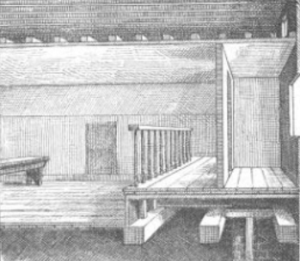
On November 26, 1875, The New York Sun ran a spectacular expose providing detailed evidence of the Eddy’s fraudulent practices. Their account and that of other major east coast newspapers that quickly picked up the story suggest that the evidence was provided by one of the sisters, and allude as well to violent quarreling among the siblings. The account included a description of the secret passage that ran between the chimney of the home and the spirit cabinet [Image at right] where family members sat during their sessions, with siblings not typically seen during the sessions donning an array of costumes for the performances.
In the aftermath of the sustained negative publicity, most of the family went their separate ways. According to one account, William had moved out just before the scandal, leaving the house to Horatio. After a short time in Moravia, New York then Ancora, New Jersey with some other siblings, William resumed life as a traveling medium. After another arrest in February 1878, when family members were arrested in Albany for practicing Spiritualism without an entertainer’s license, the sympathetic Shaker Elder Evans invited William and the other family members who had been traveling with them to come to his community in Mt. Lebanon. William and unnamed other sibling resumed conducting séances there in a Shaker-built spirit cabinet. Horatio remained in the house, and by June was practicing spirit photography. Mary continued to work as a medium until the 1800s. Her death in December 1910 permanently ended her long career. Horatio lived until 1922, and William until 1932. [Im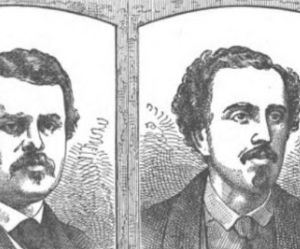 age at right]
age at right]
DOCTRINES/BELIEFS
Little available evidence suggests that the Eddys were practicing Spiritualists, or that their performances originated out of any specific religious beliefs. Henry Olcott’s account describes their father, and most of the families of the region, as strict Methodists but that their mother Julia had Spiritualist affiliation. The epitaph “Passed to Spirit Life” on William’s gravestone suggests that he at least took some spiritualist tenets seriously. Nonetheless, the influence, the Eddy séances exerted a remarkable influence on other important religious movements of the time. Helena Blavatsky apparently traveled to Chittenden in October 1874 on behest of her Master. Had she not done so and not met Olcott, Theosophy, one of the foundations of twentieth-century Western occultism, may not have developed. Marc Demarest asserts: “Henry Steel Olcott’s People from the Other World, as much as any document, marks the beginning of Spiritualism’s declension, and the first tentative constructions of the modern occult.” In his study of the relationship between the Eddys and the Mt. Lebanon Shakers, Christian Goodwillie concludes that despite the evident fraudulence of the Eddy performances, their mutual association furthered “the broader goals of Shakerism in concert with the global explosion of Spiritualism as a practical religion.” Even the most scathing and skeptical of the many newspaper exposes published during their career were hesitant to conclude that the fraudulence of the Eddys meant that Spiritualism itself was fraudulent.
RITUALS/PRACTICES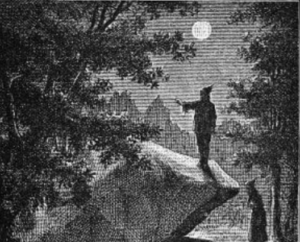
Little available evidence suggests that the Eddys were practicing Spiritualists, or that their performances originated out of any specific religious beliefs.Once the family had stopped traveling and settled down at the Spirit Vale, séances took place in the Circle Room, a large, long loft above the main family quarters,with the spirit cabinet placed at one end and the audience in rows some distance away. A rail separated the audience from the mediums. During a day’s session, the Eddys typically offered three types of séances: light (held in daylight), dark (at night or in darkness), and outdoors. The favored locale for the outdoor sessions was a rock formation known as Honto’s Cave, so named for the spirit of a Native American woman who was supposed to reside there, and who was a favorite manifestation. [Image at right] The Eddys specialized in multiple manifestations, several spirits at a time and/or large numbers (twenty or fifty or so) in one session. Sometimes the spirits would appear as loved ones of audience members and converse with them; at other times the spirits took the form of local Native people. During Madame Blavatsky’s visit, many of the spirits were European, and the Shaker audiences found themselves communicating with the spirits of their departed elders. [Image at right] 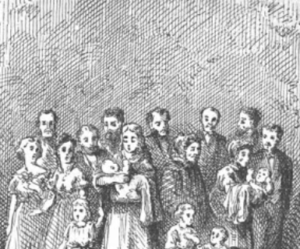
ORGANIZATION/LEADERSHIP
The three primary mediums in the Eddy performances were William, Horatio, and Mary. Their career underwent three phases: traveling as part of a performing troupe between 1864 and 1869 under various managers, the Spirit Vale period between 1873 and 1875, during which the entire family participated in séances, and after 1875, when the family scattered. William and some other siblings lived among the Shakers, and other siblings took up solo careers as mediums, spirit photographers, and the like. The most significant period of traveling troupe performances began in December 1866 when William and Mary began traveling with The Davenport Brothers who innovated much of the stagecraft the Eddy’s and other acts successfully appropriated. The Spirit Vale sessions apparently involved the entire family, with William, Mary, and Horatio as primary mediums and other siblings assisting behind the scenes. After these sessions ended, the family went their separate ways in different groupings.
ISSUES/CHALLENGES
Unlike the Fox Sisters, who themselves confessed to the fraudulence of their spirit communications, the similarly and repeatedly discredited Eddys were clearly more focused on mediumship as money-making entertainment than as a spiritual practice. Threats of exposure were part and parcel of any mediumistic exhibition, if for no other reason than any failure of skeptics to prove fraud enhanced the reputation of the mediums. Thus skeptics as well as true believers made up a significant portion of any public séance audience, and the tone of the many newspaper accounts of mediumistic performances alternated between celebratory affirmation of the existence of an afterlife and ironic mockery of audience credulity. Although the Eddy séances were celebrated for their seeming authenticity and their Spirit Vale performances drew the attention of intelligent scholars and religious leaders, the self-evident fraudulence of their performances undermined not only their credibility, but the credibility of serious and authentic practicing Spiritualists.
Numerous other factors besides the perennial issue of authenticity led to a general erosion of Spiritualism in the early twentieth century. Nonetheless, some other forms of Spiritualism have persevered in the United States, such as Spiritualist churches and camps, and Spiritualist practice within Black communities that finds current expression in cultural, African-centered practices.
IMAGES
Image #1: The Eddy Homestead.
Image #2: Julia Eddy’s gravestone.
Image #3: Davenport Poster.
Image #4: The Eddy’s Cabinet.
Image #5: William and Horario Eddy.
Image #7: Honto’s Cave.
Image #8: Spirits Visitation.
REFERENCES
“An Evening with the Spirits.” 1864. Brooklyn Daily Eagle, November 11.
Benoit, Brian. 2020. “Ghosted: The Eddy Family’s Questionable Claims to Occult Powers in Nineteenth Century Vermont.” Readex Blog. Accessed from https://www.readex.com/blog/ghosted-eddy-family%E2%80%99s-questionable-claims-occult-powers-nineteenth-century-vermont on 8 March 2021.
Demarest, Marc. 2015, “Honto’s Cave: Some Notes on the Mediumship of the Eddy Family.” Chasing Down Emma: Resolving the Contradictions of, and Filling the Gaps in, the Live, Work and World of Emma Hardinge Britten. Accessed from http://ehbritten.blogspot.com/2015/10/hontos-cave-some-notes-on-mediumships.html on 8 March 2021.
Goodwillie, Christian. 2015. “Light and Dark Sides of Spiritualism: The Eddy Brothers and the Shakers.” Communal Societies Quarterly 9:200-22.
“The Eddy Brothers.” 1875. Boston Globe, February 2.
“The Eddy’s Humbug Exposed.” 1875. The Albany Times, March 23.
“The Latest Performance of the Eddys.” 1876. Rutland Daily Globe, June 22.
The Theosophist. 1908. 29:9.
Land, Grebory R. 2020. Spiritualism in the American Civil War. Jefferson, NC: McFarland and Company.
Olcott, Henry Steel. 1875. People from the Other World. Hartford, CT: American Publishing Company. 1875.
Publication Date:
15 March 2021
